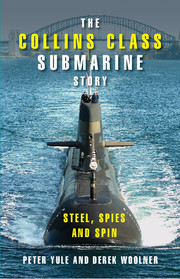Book contents
- Frontmatter
- Contents
- List of key people
- List of acronyms
- Introduction
- Part 1 You Can't Build Submarines in Australia
- 1 ‘The one class of vessel that it is impossible to build in Australia’: Australia's early submarines
- 2 Australia's Oberon class submarines
- 3 The submarine weapons update program and the origins of the new submarine project
- 4 The new submarine project
- 5 ‘We can't build submarines, go away’: Eglo Engineering and the submarine project
- 6 The acts of the apostles
- 7 ‘But how will you judge them?’: the tender evaluation process 1984–85
- 8 Spies, leaks and sackings: from tender evaluation to project definition study
- 9 The project definition study 1985–86
- 10 Debating the laws of physics: picking winners 1987
- Part 2 The Honeymoon Years 1987–92
- Part 3 ‘A Strange Sense of Unease” 1993–98
- Part 4 Resolution
- Notes
- Index
5 - ‘We can't build submarines, go away’: Eglo Engineering and the submarine project
Published online by Cambridge University Press: 05 September 2013
- Frontmatter
- Contents
- List of key people
- List of acronyms
- Introduction
- Part 1 You Can't Build Submarines in Australia
- 1 ‘The one class of vessel that it is impossible to build in Australia’: Australia's early submarines
- 2 Australia's Oberon class submarines
- 3 The submarine weapons update program and the origins of the new submarine project
- 4 The new submarine project
- 5 ‘We can't build submarines, go away’: Eglo Engineering and the submarine project
- 6 The acts of the apostles
- 7 ‘But how will you judge them?’: the tender evaluation process 1984–85
- 8 Spies, leaks and sackings: from tender evaluation to project definition study
- 9 The project definition study 1985–86
- 10 Debating the laws of physics: picking winners 1987
- Part 2 The Honeymoon Years 1987–92
- Part 3 ‘A Strange Sense of Unease” 1993–98
- Part 4 Resolution
- Notes
- Index
Summary
The story of the Collins class submarines is full of larger than life characters, but none more so than the inimitable Hans Ohff–fiery, dedicated, dogmatic and brilliant, he played a little-known but critical role in the birth of the project, before returning to centre stage as the managing director of the Australian Submarine Corporation in the project's most controversial phase. Hans Ohff grew up near Hamburg and came to Australia in 1967 after training in engineering and economics. During his engineering training he did a full apprenticeship in marine engineering and when he signed up to come to Australia ‘for the adventure’ on a £10 fare he was accepted on the basis of his tradesman's certificate rather than his university qualifications, which were not recognised in Australia.
Ohff got a job with Eglo Engineering Services counting nuts and bolts in their workshop in Sydney. Eglo had been founded in about 1952 by Eric Glowatsky and became a public company in 1966, when it had about 300 employees.
Hans Ohff moved to Melbourne to become Eglo's chief estimator and procurement manager, working on the Shell refinery at Corio and building oil and gas platforms for Bass Strait. Eglo received an enormous boost when it won the contract to do the mechanical installation for the world's largest copper mine on Bougainville. The job was bigger than the company several times over, but it was completed successfully and the profits from that one job were greater than the shareholder equity in the firm.
- Type
- Chapter
- Information
- The Collins Class Submarine StorySteel, Spies and Spin, pp. 37 - 43Publisher: Cambridge University PressPrint publication year: 2008



